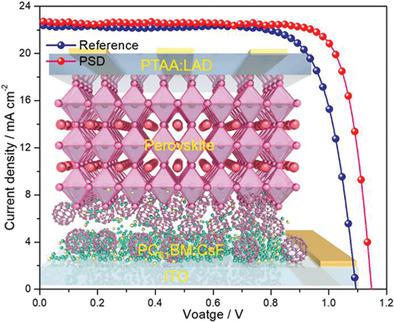当前位置:
X-MOL 学术
›
Adv. Funct. Mater.
›
论文详情
Our official English website, www.x-mol.net, welcomes your feedback! (Note: you will need to create a separate account there.)
Vertical Phase Separated Cesium Fluoride Doping Organic Electron Transport Layer: A Facile and Efficient “Bridge” Linked Heterojunction for Perovskite Solar Cells
Advanced Functional Materials ( IF 18.5 ) Pub Date : 2020-05-20 , DOI: 10.1002/adfm.202001418 Jianxing Xia 1 , Junsheng Luo 1 , Hua Yang 2 , Fengjiao Zhao 3 , Zhongquan Wan 1 , Haseeb Ashraf Malik 1 , Yu Shi 1 , Keli Han 4 , Xiaojun Yao 5 , Chunyang Jia 1
Advanced Functional Materials ( IF 18.5 ) Pub Date : 2020-05-20 , DOI: 10.1002/adfm.202001418 Jianxing Xia 1 , Junsheng Luo 1 , Hua Yang 2 , Fengjiao Zhao 3 , Zhongquan Wan 1 , Haseeb Ashraf Malik 1 , Yu Shi 1 , Keli Han 4 , Xiaojun Yao 5 , Chunyang Jia 1
Affiliation

|
In perovskite solar cells (PSCs), the interfaces of the halide perovskite/electron transport layer (ETL) and ETL/metal oxide electrode (MOE) always attract and trap free carriers via the surface electrostatic force, altering quasi‐Fermi level (E Fq) splitting of contact interfaces, and significantly limit the charge extraction efficiency and intrinsic stability of devices. Herein, a graded “bridge” is first reported to link the MOE and perovskite interfaces by self vertical phase separation doping (PSD), diminishing the side effect of notorious ionic defects via both reinforced interface E bi and the vacancies filling. Experimental and theoretical results prove that the inhomogeneous distribution of CsF in the bulk or surface of PC61BM would not only form metal–oxygen (M–O) dipole on MOE, reinforcing the interface E bi, but also create a graded energy bridge to alleviate the disadvantage of band offset raised by the enhanced interface E bi, which significantly avoid the carrier accumulation and recombination at defective interfaces. Employing PSD, the power conversion efficiency of the devices approaches 21% with a high open‐circuit voltage (1.148 V) and delivers a high stability of 89% after aging 60 days in atmosphere without encapsulation, which is the highest efficiency of organic electron transport layers for n–i–p PSCs.
中文翻译:

垂直相分离的氟化铯掺杂有机电子传输层:钙钛矿型太阳能电池的便捷高效的“桥”连接异质结
在钙钛矿太阳能电池(PSC)中,卤化物钙钛矿/电子传输层(ETL)和ETL /金属氧化物电极(MOE)的界面始终通过表面静电力吸引和俘获自由载流子,从而改变准费米能级(E Fq)接触界面的分裂,并严重限制了器件的电荷提取效率和固有稳定性。本文中,首次报道了通过自垂直相分离掺杂(PSD)将MOE和钙钛矿界面连接起来的渐变“桥”,从而通过增强的界面E bi和空位填充减少了臭名昭著的离子缺陷的副作用。实验和理论结果证明,CsF在PC 61的整体或表面中分布不均匀BM不仅会在MOE上形成金属-氧(M-O)偶极子,从而增强界面E bi,而且会创建渐变的能量桥,从而减轻增强界面E bi引起的谱带偏移的缺点,从而显着避免载流子有缺陷的接口处的累积和重组。利用PSD,在高开路电压(1.148 V)下,器件的功率转换效率接近21%,并且在大气中老化60天后无需封装即可提供89%的高稳定性,这是有机电子传输的最高效率n–i–p个PSC的层。
更新日期:2020-07-02
中文翻译:

垂直相分离的氟化铯掺杂有机电子传输层:钙钛矿型太阳能电池的便捷高效的“桥”连接异质结
在钙钛矿太阳能电池(PSC)中,卤化物钙钛矿/电子传输层(ETL)和ETL /金属氧化物电极(MOE)的界面始终通过表面静电力吸引和俘获自由载流子,从而改变准费米能级(E Fq)接触界面的分裂,并严重限制了器件的电荷提取效率和固有稳定性。本文中,首次报道了通过自垂直相分离掺杂(PSD)将MOE和钙钛矿界面连接起来的渐变“桥”,从而通过增强的界面E bi和空位填充减少了臭名昭著的离子缺陷的副作用。实验和理论结果证明,CsF在PC 61的整体或表面中分布不均匀BM不仅会在MOE上形成金属-氧(M-O)偶极子,从而增强界面E bi,而且会创建渐变的能量桥,从而减轻增强界面E bi引起的谱带偏移的缺点,从而显着避免载流子有缺陷的接口处的累积和重组。利用PSD,在高开路电压(1.148 V)下,器件的功率转换效率接近21%,并且在大气中老化60天后无需封装即可提供89%的高稳定性,这是有机电子传输的最高效率n–i–p个PSC的层。
















































 京公网安备 11010802027423号
京公网安备 11010802027423号